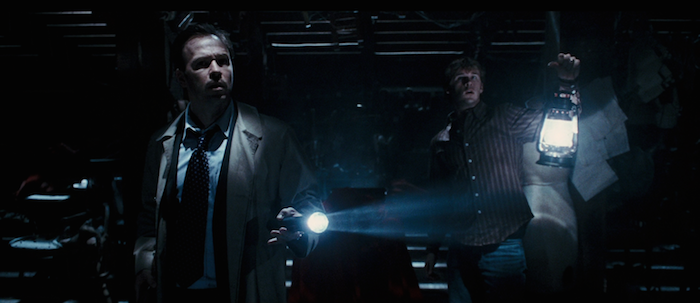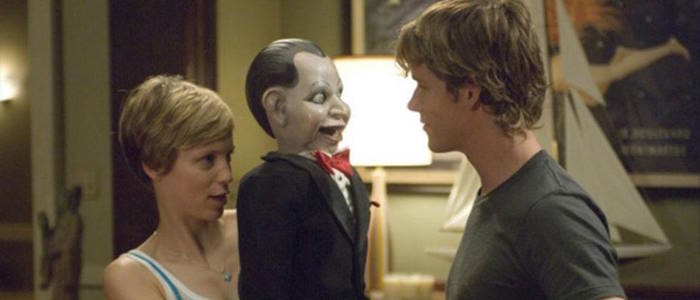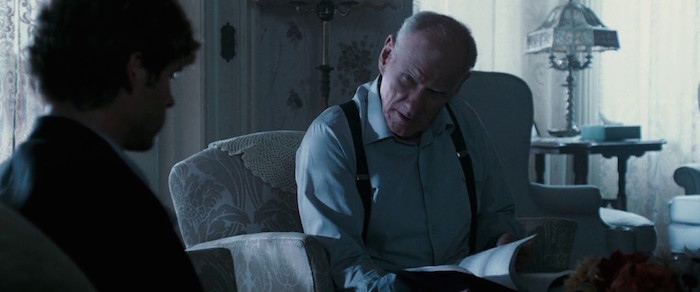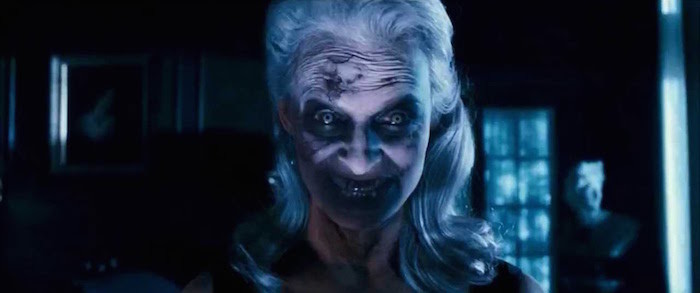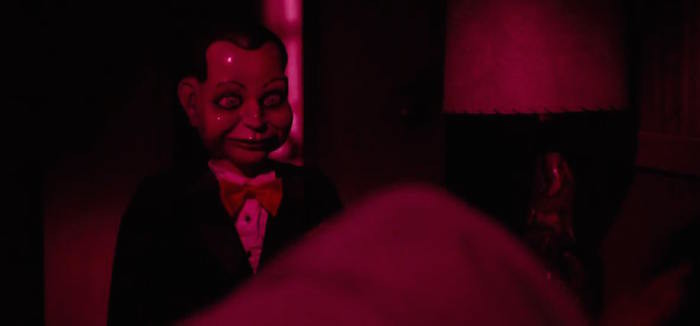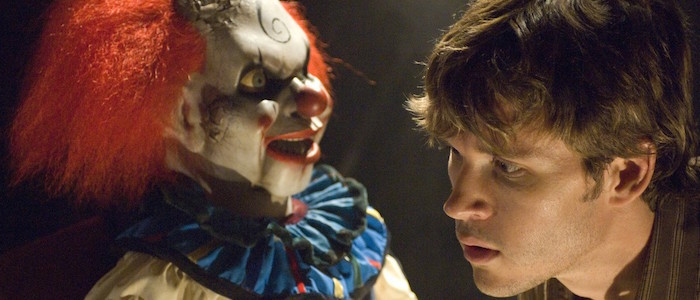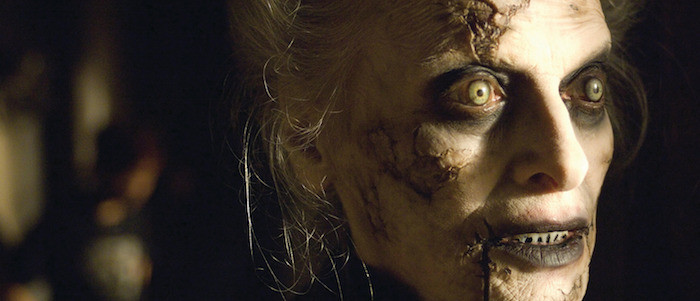The Unpopular Opinion: 'Dead Silence' Is One Of James Wan's Best Movies
(Welcome to The Unpopular Opinion, a series where a writer goes to the defense of a much-maligned film or TV show, or sets their sights on something seemingly beloved by all. In this edition: Dead Silence is the first true James Wan movie and an unfairly maligned gem.)
It's impossible to ignore James Wan's impact on the horror genre over the last decade and change. Saw put both Wan and "torture porn" on the map, Insidious revamped haunted house architectures, The Conjuring scared up record-breaking box office numbers – and that's to start. Tack on successful sequels (Insidious: Chapter 2 and The Conjuring 2), a respectful entry in the Fast and Furious saga (sending off Paul Walker), and him being handed the reins to a DC property in Aquaman. Wan is, undeniably, a Hollywood juggernaut who went from indie darling to household name by riding a wave of deserved praise for doing the impossible. Igniting franchises. Building cinematic universes. Redefining our nightmares. He is so very...wanderful Pulitzer, please.
Alas, some of his movies have been forgotten along the way. Travel back in time with me, won't you? Let's jump back a decade. Back to when James Wan was still trying to emerge from under the shadow of Saw. Back to when he made one of his best movies. Back when no one gave the terrific Dead Silence the time of day.
A Critical and Box Office Bomb
The year 2007 brought us two separate James Wan titles on the heels of Saw. One a Kevin Bacon thriller called Death Sentence, appropriately viewed as an unofficial Death Wish remake. Underrated in its own right. The other? A beyond-chilling ghost story called Dead Silence that garnered an undesirable 21% on Rotten Tomatoes. Critics labeled it "pointless" and "clichéd," calling Wan out for recycling Saw techniques for a hopeful new franchise. Box office results weren't much better – that $22 million gross (domestic and foreign) doesn't look impressive next to the film's $20 million budget. That's still $5 million more than Death Sentence grossed, but it was a bullet-to-the-head for a potential Dead Silence franchise.
We talk about movies like Saw ($100+ million gross), Insidious ($97 million gross) and The Conjuring ($318 million gross) for an obvious reason – audiences showed up. Butts were in seats, word of mouth spread, and the fanfare came rolling in. So why did critics savage Dead Silence (audience rating a 3.1-out-of-5), leaving it a mere afterthought when audiences stayed away? I have no idea, because the movie I watched deserves just as much praise as any of Wan's more "presentable" franchises. It's as good as his more acclaimed and successful horror movies in every way.
Audiences made a massive mistake by skipping out on Wan's mischievous Victorian mystery; one that gleams Grand Guignol beautification mixed with desolate, cursed-town cryptics sucked from Stephen King's essence. You think that Annabelle doll is scary? Wan and notorious partner-in-crime Leigh Whannell sketch the perfect dummy for their ventriloquist from hell, only adding to the short-lived legend of Mary Shaw. Set pieces are spectacular, period creeps shine and Wan shows, only in his sophomore feature, flashes of every single signature we praise on high each time he directs. Saw may be where it all started (unless you count his 2000 flick Stygian, which, you probably don't), but Dead Silence is where his future visions come alive.
Setting the Scene
The film opens on Jamie Ashen, played by Ryan Kwanten, and his wife Lisa (Laura Regan). A package appears at their apartment door. They tear back the wrapping to reveal a box lined with velvety redness, encasing a dead-eyed dummy. Jamie has flashbacks to a hometown legend who went by the name of Mary Shaw – a ventriloquist performer who faced mob justice after murdering a child – and her doll, Billy. The Ashen's new roommate couldn't possibly be related, right? Jamie leaves to get take-out, Lisa stages a prank by placing her new toy under Jamie's bedsheet, but then everything goes silent. Lisa hears a voice and approaches Billy – and that's her last act. Jamie returns home and finds his wife with her jaw ripped open. He pulls back the box's lining. "Mary Shaw And Billy" it reads. Time for a trip back home to Ravens Fair, in search of answers and closure that, of course, brings Jamie face-to-face with his worst fears.
What transpires is a fierce exchange of jab scares, atmospheric devastation, and nu-school similarities to Vincent Price classics. Scenes jump from the hokiest theater bits to crippling, pale-faced terror merely with the drop of sound. That's Mary's signature – when the undead ghoul is about to appear, her victim can hear nothing but direct sonic imprints. A door they open or step they thump. No whining orchestral strings or typical noise filler. We enter Mary's world, which flips a switch on old-fashioned frights in favor of pure paranormal punishment. As if her creepy, humanistic dolls and Wan's manipulation of darkness aren't enough? Dead Silence has no reservations about showing Mary's full form, lunging towards camera or floating forward slowly with a soul-sucking grin.
Building a World
If there's something Wan has become most known for, it's breathing life into full atmospheres. He molds characters, erects unknown locales from the ground-up and brings everything together like an art installation that operates on numerous mechanical levels. Insidious starts with an outside view of the most mundane suburban house, but inside becomes a chamber of lost souls expanded by "The Further." The Conjuring buttons up a '70s homeliness that Wan dresses every cinematic facet in. He doesn't just make movies, he builds worlds – and Dead Silence is no different.
Ravens Fair is a town stuck in time, full of dilapidated buildings and paranoid townsfolk who fear Mary Shaw's return. Storefronts represent a mosaic of broken glass and "Closed For Good" signage. The town's grand theater (simply named "Guignol Theater") now exists as a graveyard garden, cushy seats and delicate trimmings covered by overgrown vines and dead tree skeletons. Every step Jaime takes reaches farther into Ravens Fair's demonstrable history, now fogged by a sullen gray haze that echoes the pain captured in Kwanten's performance. Color pops most when the dead come to play, telling of Wan's ability to convey story through visuals alone.
The James Wan Trademarks
What about Wan's panic-inducing playground of light and dark? Every single movie of his features at least one or two paralyzing moments where infinite shadows blanket a sinister surprise. The Conjuring's hand clap. Insidious' bedroom scene where, off to the side, stands his demon's outline. The Conjuring 2 and the Nun painting. Wan takes our fear of the dark and abuses us like Batman's Scarecrow might, but you'd be a fool to think this manipulation didn't start in Dead Silence.
Haters of the claustrophobic will point to when Michael Fairman's Henry gets Mary Shaw'ed as their favorite watch-through-crossed-fingers scare, but there's one better. What about when Jamie attempts to sleep the night off in a Ravens Fair motel? Billy has been propped against his room's window, the neon red sign outside blinking a hellish red hue. Then, the sound drops. There's a quick Billy scare, but that's only Round 1. Jamie then sees Mary Shaw sitting in the corner. Her face turning, and then beginning to smile. All the while the sign – Jamie's only light source at the moment – is flickering on and off. With every short blackout, Mary becomes more fixated on Jamie. It is, without argument, one of Wan's more destructive scares by way of pitch blackness.
Billy vs. Annabelle
Even Mary Shaw herself – and Billy to some extent – echo later designs in Wan's filmmaking. Remember The Bride In Black? Or the withering apparition thus far known as The Nun? Shades of Mary Shaw. A pale corpse made to resemble her 101 puppets. And Annabelle who? Billy is ten times the haunter. All those creepy moments in Annabelle and Annabelle: Creation when her head switches positions is child's play compared to Billy's eye-dart. It's like the Goosebumps illustration of Slappy, pocket square and stone-cold gaze – childhood fears given form. You can hear the most unsettling creek when Billy's peepers move side to side, as Anthropomorphobia vibes are blasted on high. These two are a devilish demonic team who Wan carves from innocence scorned. Beware the stare of Mary Shaw – you bet your ass I do.
Comparisons to Annabelle really get me because while director David F. Sandberg utilizes the same command of darkness in Annabelle: Creation, Billy is bar-none the scariest Waniverse doll. Annabelle has zero creep value, with her sunken eyes and tiny mouth. Billy's definition is more human, smooth head and icy, emotive facial expressions. Every time his mouth goes agape, his little ventriloquism jaw popping open, is a heart-stop moment. Even more so when Billy sits shotgun in Jamie's car, and his eyes fixate ever so slowly on the driver. Wan's lens is positioned where we see Jamie's unaware peripheral and Billy, all buckled in, starts showing signs of life. Annabelle can't do that. Annabelle is a prairie farce compared to Mary Shaw's sidekick. Yet he's the one we burned at the stake. A life of terror, cut oh-so short.
Earning the Jump Scares
The next point I don't take lightly, but after multiple watches, I can confirm that Dead Silence earns every jump scare, infinitely more than so many generic horror titles that've collected bigger box office sums over the years. For each Billy-in-a-window scene, there's a slow-panning stalk featuring Mary Shaw. The opening kill where Lisa is mangled and dummified by Mary Shaw is enough to start a legend, and it only gets better. Wan has a sense of squeamish fun about the whole film that keeps spirits high, not to mention genuine tension in the form of Mary's cinematic treatment.
Then, after Wan teases us with secret rooms and rickety catwalks, we get our backstage finale. Everything is tied together. The Ashen case, Michael's body, Jamie's innocence – all handled tightly. Wan turns cataclysmically carnivalesque, unveiling a massive display wall of every single unearthed dummy. Mary's entire collection (minus Billy). One hundred antique heads turning left. We hear a whisper. Pan to a single circus clown doll that looks like the evilest Bozo incarnate you'd imagine (Poltergeist anxiety part deux). Mary's tongue licks Jamie through the clown's mouth, her hands then grasping Mr. Clown from behind. Effusive usage of puppetry, harnessing funhouse freakishness and slack jawed tension that laughs directly in your face – Mary's greatest trick.
To those that have laughed their way through this opinionated tribute, I beg you watch Dead Silence again – knowing all the gags in play only makes repeat viewings more amusing. The first time we meet Edward Ashen (Bob Gunton), flushed of blood and wheelchair bound is a great example. His new wife is always positioned behind him, her hand hidden. Even his wardrobe, a dapper tux and tight bowtie, scream the dark truth. Every detail woven into the mythos of Ravens Fair, Mary Shaw pulling the strings one by one, is worth savoring.
The True Beginning For James Wan
Knowing that wee little James Wan would someday parlay all these trademarks into an unstoppable filmmaking brand makes Dead Silence all the more fascinating. There's a wealth of riches here waiting to be mined, and maybe a more open generation of fans who are used to Wan's strengths will devour this ghastly sideshow. The smallest retribution for how it was initially received.
Is this bastard child of Wan's horror household perfect? By no means. While I personally love the rapid-fire ending that culminates with my most hated horror cliche – anything rocketing towards screen – it does admittedly feel extremely Saw-ish. Like, "Hey this worked in Saw!" written all over. Noted. And did Ryan Kwanten become the next Brad Pitt? No, but it's certainly not a career-ending turn.
Dead Silence is, in many ways, where it all began again for James Wan, but no one recognizes that. Instead they bash a dead corpse because...well, I don't know why. If you're one of those who've avoided Dead Silence solely on feedback alone, do yourself a favor and give it a whirl. Preferably with the lights off, and a blanky nearby. Then maybe you'll see the light and realize, after all these years, how truly underappreciated Dead Silence is – and I'll be leading the chorus.

